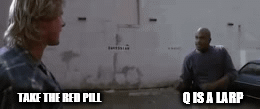

Historical Derp
slightly slide-y
https://www.mirror.co.uk/news/us-news/man-who-killed-americas-most-14323359
Did John Wilkes Booth escape justice and die in 1902?
I’d read speculation on this topic before - on various off-the-beaten-path websites - but this is the first mention I’ve seen in the MSM.
Is the dam starting to break?
~ ~ ~ ~ ~
texokie reply:
Wow!
Interesting information on that technological proof of John Wilkes Booth getting away with his crime, generally!
Here are some other links to that St. Helen alias. A community in North Texas has long held that one of their residents, St. Helen was in reality THE John Wilkes Booth.
http://www.granbury.org/705/John-Wilkes-Booth
This article explains that someone has written a play depicting the story of St. Helen in Granbury, TX.
The following is such an interesting article, I include it in its entirety for FReeQs' (and anons', lurks' and freepers') edification as well as for documentation. http://www.texasescapes.com/CFEckhardt/Did-John-Wilkes-Booth-Live-In-Texas.htm
Did John Wilkes Booth Live In Texas?
by C. F. Eckhardt
Wherever and whenever John Wilkes Booth, assassin of Abraham Lincoln, died, it’s pretty much a sure bet it wasn’t in a burning barn in Virginia. Booth had coal-black hair and a clear complexion. When he made the leap from the Presidential box to the stage of Ford’s Theater, he landed on his left foot and broke his left ankle. The man who assisted Booth in mounting behind the theater testified that he couldn’t put weight on his left foot. Dr. Samuel Mudd testified that he splinted Booth’s left ankle. Testimony from eyewitnesses to the shooting of ‘Booth’ in the barn described a man with sandy hair and freckles. His right ankle was broken. There are a number of other circumstances to indicate the man shot in Virginia wasn’t John Wilkes Booth, but these two alone are sufficient to cast more than reasonable doubt on the identification.
Five years after the Lincoln assassination a young, very handsome, black-haired man with a clear complexion turned up in the tiny town of Glen Rose, Texas. He gave his name as John St. Helen. Although he didn’t drink himself, he worked as a bartender. He also acted in amateur theatrical productions in Glen Rose. He had tremendous stage presence, excellent diction and delivery, and was obviously at home on the stage. He also had an almost encyclopedic mastery of the plays of William Shakespeare.
John St. Helen remained in Glen Rose a little less than a year. A local politician’s daughter was to be married. Included on the guest list were a number of US Army officers and the United States Marshal for the Eastern District of Texas. St. Helen got word of the guest list—and promptly vanished.
He turned up about a year later in Granbury. His closest local friend, a lawyer named Finis L. Bates, noticed something. While St. Helen drank not a drop 364 days a year, on one specific day he drank himself into a stupor. That day was April 14—the anniversary of the Lincoln assassination.
St. Helen fell gravely ill while in Granbury. He was told he would probably die of the illness. Local doctors did all they could, but without apparent effect. St. Helen summoned Bates to his bedside and made what he obviously believed was a deathbed statement. “My name,” he said, “is not John St. Helen. I am John Wilkes Booth, the assassin of Abraham Lincoln.”
For a deathbed statement to be admissible in court, three conditions must be fulfilled. The person must believe he is dying. The statement must be made voluntarily. The person making the statement must then die within a reasonable period.
John St. Helen certainly believed he was dying. He made the statement entirely voluntarily. However, he recovered. He never retracted the statement. Instead, he disappeared from Granbury, leaving no forwarding address. Upon searching St. Helen’s rented room after his departure, Bates found a Colt single-shot pocket pistol of a type first manufactured in 1866. It was wrapped in the front page of a Washington, DC newspaper dated April 15, 1865. Bates never heard from St. Helen again.
In 1906 a drunken derelict who used the name David George died in Enid, Oklahoma. On his deathbed he claimed to be John Wilkes Booth. Bates went to Enid to examine the corpse. In the bloated, alcohol-ruined face and body of the man called David George he believed he recognized his old friend, John St. Helen. He claimed the body and had it embalmed—mummified is perhaps a better description—and tried to interest the government in it. There was no interest.
Bates kept the body in storage for a number of years. Then, somehow, it passed out of his possession. From the 1920s through the early 1960s it was a sideshow attraction at various carnivals and circuses—“The Corpse of John Wilkes Booth, the Assassin of Abraham Lincoln.” An X-ray of the body revealed that, many years before, the man’s left ankle had been broken—and was never properly set.
John Wilkes Booth was known to be fond of cryptograms. The name ‘John St. Helen’ could easily be a cryptogram. The first name is, of course, Booth’s own—but also one of the most common given names for men, then and now. ‘St. Helen’ could very well be merely the anglicized version of Bonaparte’s second isle of exile, Ste. Helena. Is the name saying ‘John the Exile?’ Booth certainly was an exile—from society, from his family, from the theater he loved.
How about ‘David George?’ David Herrold and George Atzerodt were two of Booth’s known co-conspirators. Was John St. Helen/David George, if they were in fact the same person, actually John Wilkes Booth?
At this point in time there is no way to prove—or disprove—that. The mummy, which was a traveling exhibit with circuses and carnivals for over 40 years, has disappeared. No one has seen it in nearly a half-century, though photographs of it exist, the skin turned almost coal black from the preservation process. Booth family heirs have refused permission for the corpse of the man shot in Virginia to be exhumed for DNA testing. Did John Wilkes Booth live in Glen Rose and Granbury, Texas, in the 1870s and die in Enid, Oklahoma, in 1906? In that fine old southwestern phrase, ¿quien sabe?
© C. F. Eckhardt
June 30, 2007

